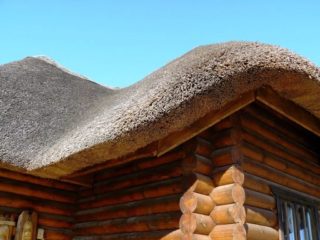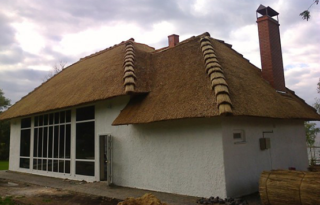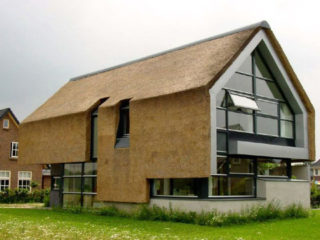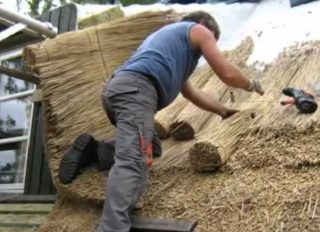Roofing made of natural material gives the house individuality and special style. The reed roof can compete with modern building materials in terms of performance characteristics. It can withstand rain and snow, gusts of wind and summer heat. Reeds, laid with the right technology, provide a durable and reliable coating.
Reed characteristics and preparation

A plant from the sedge family grows in moist soil, along the banks of rivers, lakes, swamps. Stems are cylindrical, smooth, hollow, reaching 2-4 meters in height. They are flexible and durable, bend under the influence of the wind, but do not break. The reed is resistant to dampness, does not swell when wet. Common reed and cattail are also natural materials for roofing. All plants are similar in appearance, characteristics and habitat.
The reeds are harvested in late autumn, when the plant turns golden brown and falls asleep for the winter. Raw materials are taken from floodplains of rivers and lakes, salt water deteriorates the quality of the material. Stems 1-2 m long and 5-8 cm in diameter are selected. Their age is up to 1 year. Plants are cut by hand (sickle) or harvesters. People and equipment move on the ice, which bound the reservoir. The work takes a lot of time and effort. A large number of stems will be needed for the roofing device.
Reeds of the same length are collected in sheaves with a girth of 600 mm. The structure is connected in two places with a wire. In some technologies, panicles are used, in other cases they are cut off. The material is dried to a moisture content of 18%. Sheaves are sold in bales of 20-50 pieces.
Reed mats are also made. Their thickness is 15-35 cm. The material is used to cover outbuildings and arbors.
The uniqueness and disadvantages of a reed roof

Natural materials in the construction of houses are a step towards environmental safety and health benefits. A reed roof has several advantages that distinguish it from other roofing options:
- The material is resistant to weather conditions. It does not rot, it tolerates freezing and high temperatures. Thanks to the special technique of knitting and stacking, water penetrates only into the top layer and dries quickly.
- The durability of a reed roof is 50-60 years. Only the outer layer is destroyed, which requires renewal every 15 years.
- The natural coating is safe and does not contain harmful substances.
- The special structure of reed and reed stalks provides excellent heat and sound insulation without the use of additional materials.
- Unique Design - Flexible stems allow you to create an unusual curved roof structure. The appearance of the roof and the architectural appearance becomes original and individual.
- The reed cover creates natural ventilation and maintains the optimal temperature for the cold and hot seasons.
The disadvantages of the roof include:
- Insufficient fire resistance. Reed is a combustible material, in order to increase fire safety, it is impregnated with fire retardants and the technology of dense packing is used.
- Stacking defects in the form of sharpening stems or holes attract birds and rodents. If the roof is installed correctly, then these problems do not arise.
The advantages of a natural roof include the absence of static voltage, the minimum risk of lightning strikes.
Reed roof device

The service life of the roof and its moisture resistance depend on the correct laying. Fundamental rules:
- The angle of inclination of the slope should be at least 30 °, this will allow water flows to flow down the stems without delay. With a lower slope of the roof, it is necessary to install a waterproofing sheet, and the operating time is reduced.
- The optimal thickness of the layer of reed sheaves is 30-35 cm, the maximum is 40 cm.For outbuildings, 20 cm is enough.
- The weight of single stems and sheaves is insignificant, but due to the abundance of material, the total load reaches 40 kg / sq. m, in a wet state the mass increases. This parameter is taken into account when installing the rafter system.
- In order to protect the roof from possible fires, the height of the pipe is increased compared to standard dimensions.
- It is impossible to fix the drainage system along the edge of the reed roof, precipitation flows directly from the overhang. So that moisture does not break the blind area and is discharged in a timely manner, drainage is arranged around the perimeter of the house, which is connected to the storm sewer.
The installation of two options for the roof structure is practiced:
- Open - the material is laid on the crate, it is visible from the inside. This method is used for hotels, restaurants, gazebos.
- Closed - sheaves are attached to a solid base, a soft wire mesh is often used. The option is easier to install and looks aesthetically pleasing.
The basis for laying sheaves is a crate with a step of 25-30 cm. For its manufacture, a beam of 50 × 50 mm in size or a board of 25 mm is used. The frame is impregnated with an antiseptic. A reed roof will require an average of 10 sheaves per 1 sq. m.
When using reed sheaves, there is no need to arrange ventilation and insulation, as in other types of roofing. If the requirements for a coating thickness of 30 cm or more are met, the natural material fully protects against heat loss. The structure of the coating is permeable to air and steam. The house can "breathe", a favorable microclimate is created. Condensation does not form on the reeds, the humidity is always within normal limits.
DIY manufacturing technology and installation

When constructing a roof from reeds with their own hands, the technology of one of the European schools is used:
- Dutch is the most common roofing method in homes. Sheaves are mounted on a solid flooring. Stems up to two meters long and 5-6 mm in diameter are suitable for covering.
- Danish - differs in the use of short sheaves up to 1 m with thin reeds (4-5 mm). For work, a frequent step of the lathing is required. The technology allows you to create a roof with a complex geometric shape.
- Polish - loose sheaves are used, the ridge is made of reeds.
Step-by-step instruction:
- Screws are screwed into the crate to fix the securing wire.
- The sheaves are laid from the bottom. They are placed with panicles up. The overhang from the eaves is 50 cm.
- Sheaves are firmly fixed with 5 mm stainless steel wire. With an open design, they are sewn through. Then the sheaves are cut, the reeds are leveled with a special tool.
- The next row is laid with an overlap of 30 cm. The material is fixed horizontally every 15 cm.
- Upon reaching the top, a ridge is made of flexible tiles.
After the reeds have been laid and secured, the roof must be cleaned and tamped to keep it level and aesthetically pleasing. The work is carried out with a special heavy shovel. The reed stems are tightly hammered into bundles and seams.
Eco-friendly roofing can be used for ethnic style country houses, hotels or restaurants. The service life of a reed roof depends on the quality of the raw materials, the chosen laying technology and the skill of the roofers.








